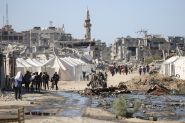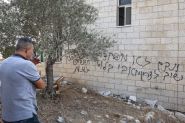
Six days into open war between Iran and Israel, the Hebrew State operates one of the most advanced air defense systems in the world, intercepting Iranian missiles over a vast arc spanning Lebanon, Syria and Iraq. Behind this technological feat lies an intricate network of radars, artificial intelligence and international military cooperation.
How does this multi-layered shield function, and how long can it withstand the pressure?
A Layered Fortress of Defense
To confront the Iranian threat, Israel relies on a tiered architecture designed to counter missiles of various ranges. At its foundation is the Iron Dome, supported by David’s Sling, the Arrow 2 and Arrow 3 systems, as well as American-made Patriot and THAAD interceptors. Each component plays a precise role in this tightly coordinated mechanism. But at the heart of every interception is one crucial element: the radar.
“Everything begins with it,” says retired General Khalil Helou in an interview with This is Beirut. “It detects the threat and instantly transmits data to a processing center, which calculates the missile’s impact point. Then, a connected battery is activated and the launch order is automatically issued.”
Artificial intelligence, he notes, is embedded throughout the system, accelerating analysis, refining decision-making and enabling near-instantaneous response.
Intercepting Missiles: A Race Against Hypersonic Speed
Intercepting a missile is one of the most complex challenges in modern warfare, and success entirely depends on the stage of the missile’s flight.
“When a missile is still in its launch or ascent phase, its speed is relatively low. That’s when it’s most exposed,” explains General Helou.
“But once it begins its descent—its reentry phase—it can reach speeds of up to 5,000 km/h. At that point, only a flawlessly precise response can succeed,” he says.
Different systems are built for different interception methods. “Iron Dome, for instance, doesn’t require a direct hit: it detonates near the target, destroying it with a pressure blast. Others, like the American THAAD system, entirely rely on kinetic impact. They carry no explosives—their sheer velocity is enough to shatter the incoming missile.”
Israel’s Arsenal: A Multi-Layered Shield
The Iron Dome, Israel’s first line of defense, comprises multiple batteries strategically deployed across the country. Each battery contains 3 to 4 launchers, with each launcher armed with 20 interceptor missiles. Designed to neutralize artillery shells, Katyusha rockets and short-range missiles with ranges of 4 to 70 kilometers, the system plays a critical role in Israel’s defense.
While Israeli officials claim a 90% interception success rate, independent assessments estimate the true rate to be between 75 and 80%, according to Helou.
Next comes David’s Sling, which targets medium-range missiles up to 300 kilometers. The system is deeply integrated with Iron Dome through shared AI and data networks, allowing both systems to operate as one continuous defensive grid.
Completing the shield are the Arrow 2 and Arrow 3 systems. Arrow 2 identifies threats at distances up to 500 kilometers and intercepts them at around 100. Arrow 3, Israel’s long-range interceptor, reaches targets as far as 2,400 kilometers. In recent days, it has reportedly been used to intercept Iranian missiles over Lebanon and Syria—marking its most extensive operational use to date.
American Support: A Cornerstone of Israel’s Missile Defense
Alongside Israel’s indigenous systems, two American platforms play a crucial role in reinforcing the country’s missile shield: the Patriot missile system, with a range of up to 160 kilometers and capable of intercepting ballistic missiles, cruise missiles, drones and aircraft; and the THAAD system, specialized in high-altitude interceptions during the terminal phase of incoming missiles.
Though operated by the United States, these systems are fully integrated into Israel’s defense network, forming a cohesive joint umbrella. “At least two THAAD batteries are believed to be deployed in Israel—out of just seven worldwide,” explains Helou. However, no system is infallible: two missiles launched from Yemen recently penetrated this advanced defense, “raising concerns about its reliability under real combat conditions,” he adds.
While American assistance remains the backbone of Israel’s missile defense, other countries also contribute. The British operate from bases in Cyprus, where 16 to 18 fighter jets are stationed, according to Helou. This presence has provoked explicit threats from Iran against Nicosia, prompting the Cypriot president to offer mediation efforts that have so far yielded no results.
France maintains a small number of aircraft stationed in Amman, Jordan, without a permanent regional base. Meanwhile, American aircraft carriers are positioned too far to provide direct support, making Cyprus the primary hub for US air operations in the region.
Iranian Tactics: Outsmarting Rather Than Overpowering
Tehran, as General Helou warns, “has yet to reveal its final strategy.” Building on experience gained in 2023, Iran combines saturation, deception and cunning to outmaneuver enemy defenses.
Their tactic begins with swarms of drones, which are difficult to detect by ground radar, sent to divert attention. “These drones, often shot down over Syria or Iraq, saturate air defenses. While radars and fighter jets are occupied tracking them, missiles are launched,” explains the military expert. The timing is precise: a drone takes 4 to 5 hours to reach Israel, while a missile covers the same distance in just 15 to 20 minutes. The goal is clear: to overwhelm defenses by striking at the moment they are stretched thin.
Another weapon in Tehran’s arsenal is the cruise missile. “Controllable in flight, these missiles can alter their trajectory or even their target. They are relatively slow—around 900 km/h—but fly at very low altitudes, making them extremely hard to detect,” adds Helou. Their vulnerability lies in the fact that they must climb to higher altitudes to strike, where they become more exposed.
Despite these efforts, Iran’s success rate remains limited. “Out of about 40 missiles launched, only 3 or 4 hit their targets. While a 10% hit rate may seem low, it still exacts a significant human, economic and psychological toll on Israel,” notes Helou.
Between sophisticated technology and diversionary tactics, the air war between Iran and Israel shows no sign of abating. With Tehran largely isolated and its military capacity finite, the pressing question is: How long can this increasingly complex conflict endure?





Comments